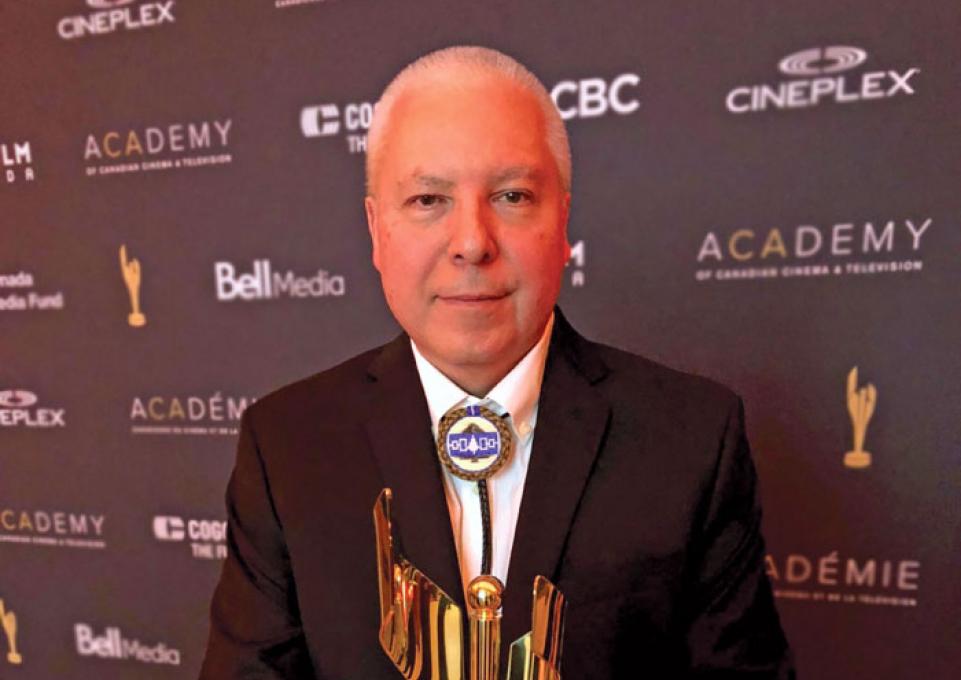
Tim Johnson, ’82, has been working on a story for almost a decade. But it’s a tale that has technically been in the making for over a century.
“The impressions that Native Americans left on twentieth-century music—including blues, jazz, and rock and roll—have been under the radar for too long,” said Johnson, who, with guitarist Stevie Salas, produced the 2017 documentary RUMBLE: The Indians Who Rocked the World.
Johnson, an indigenous educator and seasoned museum executive, served as the associate director for museum programs at the Smithsonian Institution’s National Museum of the American Indian (NMAI) in Washington, D.C., from 2006 to 2015. Among the many exhibits developed during his tenure, Johnson initiated and directed Up Where We Belong: Native Musicians in Popular Culture, which inspired an award-winning documentary about the untold contributions of American Indians to popular music.
“My exhibit assessment group was seeking concepts for exhibitions—we were searching for something that would showcase indigenous influences on American and world culture,” he said. During their collaboration to enhance the museum’s Contemporary Native Music Program, Johnson and Salas were inspired by Brian Wright-McLeod’s Encyclopedia of Native Music (University of Arizona Press, 2005).
“The book chronicles more than a century of Native music and musicians across numerous genres,” Johnson said. “When we explored what could come out of Brian’s work, we realized there was a deep and powerful story. Several of these indigenous musicians had not only achieved success in the music industry, but were also influential in helping to shape the sounds of contemporary music.”
The exhibition was on display at NMAI facilities from 2010 to 2011 in D.C. and from 2011 to 2012 in New York City. It highlighted nearly a century of indigenous musical history, brought to life with objects like a patchwork leather coat worn by Jimi Hendrix, Link Wray’s Danelectro Longhorn guitar, and a double-platinum album featuring drummer Randy Castillo.
“We didn’t want the story to die with the exhibit,” Johnson said. “Stevie and I knew we needed to find a way to make this message permanent,” which is how they solidified their vision for the 96-minute film that debuted at the 2017 Sundance Film Festival.
“I think RUMBLE can now be used as an educational tool to showcase this untold history of American music,” he said.
The film features music from such Native icons as Delta blues musician Charley Patton, jazz singer Mildred Bailey, guitarists Link Wray and Jimi Hendrix, and the group Redbone. Artists interviewed for RUMBLE include Martin Scorsese, Quincy Jones, Buddy Guy, Tony Bennett, Robert Trujillo of Metallica, Iggy Pop, Steven Tyler of Aerosmith, and Slash of Guns N’ Roses.
RUMBLE’s title was inspired by Wray’s 1958 instrumental of the same name. The song pioneered the use of “power chords” and techniques of distortion and feedback, which were largely absent in early ’50s rock and roll.
“Our work has helped tell the story of a profound and missing chapter in the history of North American and worldwide popular music,” Johnson said. “It has showcased the underlying contributions from these Native artists and their widespread influence.”
RUMBLE won all three categories for feature documentaries at the 2017 Canadian Screen Awards: Best Film, Best Cinematography, and Best Editing.
Johnson—who grew up in North Tonawanda and whose father is Mohawk—lives with his wife on Six Nations of the Grand River near Brantford, Ontario. He’s retired from the Smithsonian, but remains active on a variety of arts and education projects. He is a senior adviser to Plenty Canada, an indigenous nonprofit that supports sustainable development, and serves on the Board of Trustees for Niagara-on-the-Lake’s Shaw Festival.
“My career objective for nearly 40 years has been to educate the public about the American Indian experience,” he said. “It’s very rare to uncover a story that has been there all along, but no one has ever connected the dots. This is an American story and a human story.”
